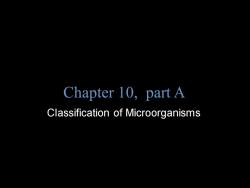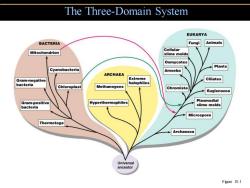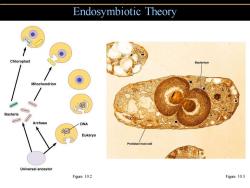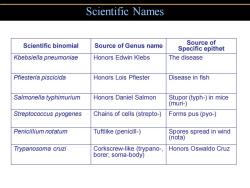《微生物学 Microbiology》课程PPT教学课件(英文版)classification of microrganisms 1/2

Chapter 10,part A Classification of Microorganisms
Copyright © 2004 Pearson Education, Inc., publishing as Benjamin Cummings B.E Pruitt & Jane J. Stein Chapter 10, part A Classification of Microorganisms

Taxonomy 。Taxonomy The science of classifying organisms Provides universal names for organisms Provides a reference for identifying organisms
Taxonomy • Taxonomy • The science of classifying organisms • Provides universal names for organisms • Provides a reference for identifying organisms

Taxonomy 。 Systematics or phylogeny The study of the evolutionary history of organisms All Species Inventory (2001-2025) To identify all species of life on Earth
Taxonomy • Systematics or phylogeny • The study of the evolutionary history of organisms • All Species Inventory (2001-2025) • To identify all species of life on Earth

Taxonomy 1735 Plant and Animal Kingdoms 1857 Bacteria fungi put in the Plant Kingdom ·1866 Kingdom Protista proposed for bacteria, protozoa,algae,fungi 1937 "Prokaryote"introduced for cells "without a nucleus" 1961 Prokaryote defined as cells in which nucleoplasm is not surrounded by a nuclear membrane ● 1959 Kingdom Fungi ● 1968 Kingdom Prokaryotae proposed 1978 Two types of prokaryotic cells found
Taxonomy • 1735 Plant and Animal Kingdoms • 1857 Bacteria & fungi put in the Plant Kingdom • 1866 Kingdom Protista proposed for bacteria, protozoa, algae, & fungi • 1937 "Prokaryote" introduced for cells "without a nucleus" • 1961 Prokaryote defined as cells in which nucleoplasm is not surrounded by a nuclear membrane • 1959 Kingdom Fungi • 1968 Kingdom Prokaryotae proposed • 1978 Two types of prokaryotic cells found

The Three-Domain System TABLE 10.1 Some Characteristics of Archaea,Bacteria,and Eukarya Archaea Bacteria Eukarya Methanosarcina E.coli Amoeba Cell Type Prokaryotic Prokaryotic Eukaryotic Cell Wall Varies in composition; Contains peptidoglycan Varies in composition; contains no peptidoglycan contains carbohydrates Membrane Lipids Composed of branched Composed of straight Composed of straight carbon chains attached to carbon chains attached to carbon chains attached to glycerol by ether linkage glycerol by ester linkage glycerol by ester linkage First Amino Acid in Methionine Formylmethionine Methionine Protein Synthesis Antibiotic No Yes No Sensitivity rRNA Loop" Lacking Present Lacking Common Arm of tRNAT Lacking Present Present "Binds to ribosomal protein;found in all bacteria. tA sequence of bases in RNA found in all eukaryotes and bacteria:guanine-thymine-pseudouridine-cytosineguanine. Table 10.1
The Three-Domain System Table 10.1

The Three-Domain System EUKARYA BACTERIA Fungi Animals Cellular Mitochondrion slime molds Oomycotes Plants Cyanobacteria Amoeba ARCHAEA Gram-negative Extreme Ciliates bacteria halophiles Chloroplast Methanogens Chromista Euglenozoa Plasmodial Gram-positive Hyperthermophiles slime molds bacteria Microspora Thermetoga Archaezoa Universal ancestor Figure 10.1
The Three-Domain System Figure 10.1

TABLE 10.2 Prokaryotic Cells and Eukaryotic Organelles Compared Eukaryotic Organelles Prokaryotic Cell Eukaryotic Cell (Mitochondria and Chloroplasts) DNA Circular Linear Circular Histones No Yes No Ribosomes 70S 80S 70s Growth Binary fission Mitosis Binary fission Table 10.2
Table 10.2

Endosymbiotic Theory ● ● Chloroplast Bacterium Mitochondrion Bacteria G4O Archaea DNA Eukarya Protistan host cell Universal ancestor Figure 10.2 Figure 10.3
Endosymbiotic Theory Figure 10.2 Figure 10.3

Scientific Names Scientific binomial Source of Genus name Source of Specific epithet Kbebsiella pneumoniae Honors Edwin Klebs The disease Pfiesteria piscicida Honors Lois Pfiester Disease in fish Salmonella typhimurium Honors Daniel Salmon Stupor(typh-)in mice (muri-) Streptococcus pyogenes Chains of cells(strepto-) Forms pus(pyo-) Penicillium notatum Tuftlike (penicill-) Spores spread in wind (nota) Trypanosoma cruzi Corkscrew-like (trypano-, Honors Oswaldo Cruz borer;soma-body)
Scientific Names Scientific binomial Source of Genus name Source of Specific epithet Kbebsiella pneumoniae Honors Edwin Klebs The disease Pfiesteria piscicida Honors Lois Pfiester Disease in fish Salmonella typhimurium Honors Daniel Salmon Stupor (typh-) in mice (muri-) Streptococcus pyogenes Chains of cells (strepto-) Forms pus (pyo-) Penicillium notatum Tuftlike (penicill-) Spores spread in wind (nota) Trypanosoma cruzi Corkscrew-like (trypano-, borer; soma-body) Honors Oswaldo Cruz

Taxonomic Hierarchy DOMAIN EUKARYA BACTERIA KINGDOM ANIMALIA FUNGI PLANTAE NONE ASSIGNED FOR BACTERIA Phylum Chordata Ascomycota Tracheophyta PROTEOBACTERIA Class Mammalia Gamma- Hemiascomycetes Angiospermae proteobacteria Order Carnivora Saccharo Rosales Enterobacteriales mycetales Family Canidae Saccharo- 月osaceae Enterobacteria mycetacea Genus Canis Saccharomyces 月o5a Species col Figure 10.5
Taxonomic Hierarchy Figure 10.5
按次数下载不扣除下载券;
注册用户24小时内重复下载只扣除一次;
顺序:VIP每日次数-->可用次数-->下载券;
- 《微生物学 Microbiology》课程PPT教学课件(英文版)chemical principles 2/2.ppt
- 《微生物学 Microbiology》课程PPT教学课件(英文版)chemical principles 1/2.ppt
- 《微生物学 Microbiology》课程PPT教学课件(英文版)biotechnology and recombinant DNA 2/2.ppt
- 《微生物学 Microbiology》课程PPT教学课件(英文版)biotechnology and recombinant DNA 1/2.ppt
- 《微生物学 Microbiology》课程PPT教学课件(英文版)applied and industrial microbiology.ppt
- 《微生物学 Microbiology》课程PPT教学课件(英文版)antimicrobial drugs 2/2.ppt
- 《微生物学 Microbiology》课程PPT教学课件(英文版)antimicrobial drugs 1/2.ppt
- 云南农业大学:《微生物学》课程教学资源(PPT课件)第四章 微生物的生长和环境条件.ppt
- 云南农业大学:《微生物学》课程教学资源(PPT课件)第六章 真核微生物.ppt
- 云南农业大学:《微生物学》课程教学资源(PPT课件)第八章 微生物的生态.ppt
- 云南农业大学:《微生物学》课程教学资源(PPT课件)第五章 原核生物.ppt
- 云南农业大学:《微生物学》课程教学资源(PPT课件)第三章 细菌的遗传和变异.ppt
- 云南农业大学:《微生物学》课程教学资源(PPT课件)第七章 病毒.ppt
- 云南农业大学:《微生物学》课程教学资源(PPT课件)绪论(主讲:刘雅婷).ppt
- 云南农业大学:《微生物学》课程教学资源(PPT课件)第二章 微生物的营养和代谢.ppt
- 云南农业大学:《微生物学》课程教学资源(PPT课件)第一章 微生物的细胞.ppt
- 《微生物学》课程教学资源(PPT课件)第八章 微生物生态.ppt
- 《微生物学》课程教学资源(PPT课件)第九章 传染与免疫.ppt
- 《微生物学》课程教学资源(PPT课件)第七章 微生物的遗传变异和育种.ppt
- 《微生物学》课程教学资源(PPT课件)第四、五章 微生物的营养与培养基.ppt
- 《微生物学 Microbiology》课程PPT教学课件(英文版)classification of microrganisms 2/2.ppt
- 《微生物学 Microbiology》课程PPT教学课件(英文版)disorders associated with the immune system 1/2.ppt
- 《微生物学 Microbiology》课程PPT教学课件(英文版)disorders associated with the immune system 2/2.ppt
- 《微生物学 Microbiology》课程PPT教学课件(英文版)domains bacteria archaea 1/5.ppt
- 《微生物学 Microbiology》课程PPT教学课件(英文版)domains bacteria archaea 2/5.ppt
- 《微生物学 Microbiology》课程PPT教学课件(英文版)domains bacteria archaea 3/5.ppt
- 《微生物学 Microbiology》课程PPT教学课件(英文版)domains bacteria archaea 4/5.ppt
- 《微生物学 Microbiology》课程PPT教学课件(英文版)domains bacteria archaea 5/5.ppt
- 《微生物学 Microbiology》课程PPT教学课件(英文版)environmental microbiology 1/3.ppt
- 《微生物学 Microbiology》课程PPT教学课件(英文版)environmental microbiology 2/3.ppt
- 《微生物学 Microbiology》课程PPT教学课件(英文版)environmental microbiology 3/3.ppt
- 《微生物学 Microbiology》课程PPT教学课件(英文版)functional anatomy of prokaryotic and eukaryotic cells 1/2.ppt
- 《微生物学 Microbiology》课程PPT教学课件(英文版)functional anatomy of prokaryotic and eukaryotic cells 2/2.ppt
- 《微生物学 Microbiology》课程PPT教学课件(英文版)fungi algae protozoa and helminths 1/4.ppt
- 《微生物学 Microbiology》课程PPT教学课件(英文版)fungi algae protozoa and helminths 2/4.ppt
- 《微生物学 Microbiology》课程PPT教学课件(英文版)fungi algae protozoa and helminths 3/4.ppt
- 《微生物学 Microbiology》课程PPT教学课件(英文版)fungi algae protozoa and helminths 4/4.ppt
- 《微生物学 Microbiology》课程PPT教学课件(英文版)microbial diseases of digestive system 1/3.ppt
- 《微生物学 Microbiology》课程PPT教学课件(英文版)microbial diseases of digestive system 2/3.ppt
- 《微生物学 Microbiology》课程PPT教学课件(英文版)microbial diseases of digestive system 3/3.ppt
